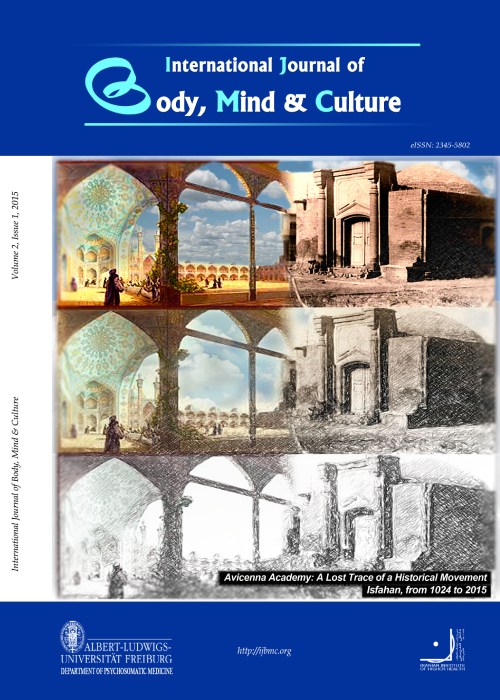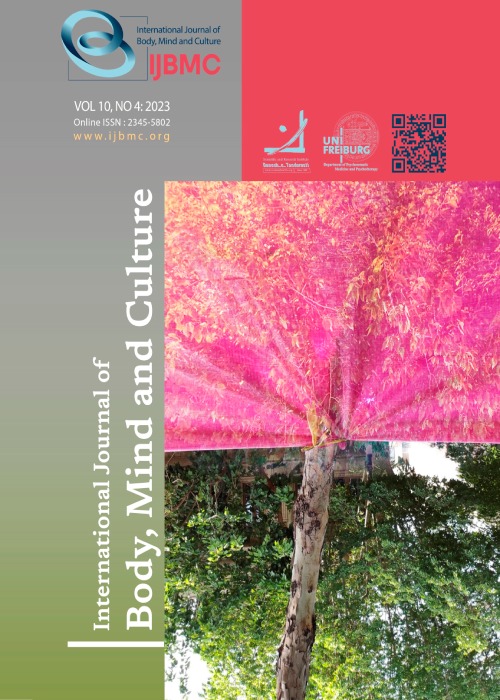فهرست مطالب

International Journal of Body, Mind and Culture
Volume:2 Issue: 1, Winter -Spring 2015
- تاریخ انتشار: 1395/02/21
- تعداد عناوین: 6
-
Pages 4-10
Death from the biomedical standpoint is a negative and technological issue. We need to be aware of death in order to have an authentic life and medical practice. Some philosophers and artists have shed some light on this dark side of modern medicine. This article is an interdisciplinary discussion on some of the conceptual art works of Damien Hirst which are focused on death and medicine. Hirst's installations and his critical point of view, which we have discussed in this essay, are some examples of how contemporary art can bring medical care closer to real-life human concern and disclose some ontological aspects of medical practice.
Keywords: Death, Modernity, Medicine, Ontology, Damien Hirst -
Pages 11-23
Various psychodynamic processes may underlie the development of psychogenic pain disorder such as conversion, the displacement of affect, or narcissistic defenses. However, many of the processes suggested are related to a disorder of affect regulation. The term affect regulation in psychoanalytic literature refers to phenomena which are often described by the concept of alexithymia. Empirical observations suggest that alexithymia is correlated to insecure attachment, especially an insecure dismissing representation of attachment. Psychodynamic psychotherapy in psychogenic pain disorder should focus on the reintegration of split-off affects which may provoke intensive counter-transference and which in order to be used therapeutically must be linked to attachment experiences within and outside of the therapeutic relationship.
Keywords: Psychogenic pain disorder, Affect regulation, Alexithymia, Insecure attachment -
Pages 24-33Background
Extraintestinal symptoms are common in patients with irritable bowel syndrome (IBS). In the present study, we determined the relationship between psychological disorders and extraintestinal symptoms in patients with IBS.
MethodsAdult patients with IBS referred to 4 gastroenterology clinics in Isfahan, Iran, completed the irritable bowel severity scoring system (IBSSS), extraintestinal symptoms scale, Hospital Anxiety and Depression Scale, and Irritable Bowel SyndromeQuality of Life (IBS-QOL) Questionnaire. Univariate and multivariate analyses were conducted.
ResultsThe patients included 113 females and 45 males with mean age of 34.8 ± 11.1 years. Cumulative frequency of extraintestinal symptoms was 3.3 ± 2.4 (0 to 10). Anxiety and depression were present in 79.7% and 54.4% of the patients, respectively. Frequency of extraintestinal symptoms was correlated with anxiety and depression (r = 0.289 to 0.531), IBS severity (r = 0.373 to 0.505), and quality of life (r = -0.317 to -0.398). Severity of IBS was independently associated with extraintestinal digestive symptoms’ frequency (A = 0.248). Female gender, education level, and anxiety were independently associated with extraintestinal non-digestive symptoms’ frequency (A = -0.225 to 0.260). Severity of IBS and frequency of non-digestive symptoms were independent predictors of quality of life (A = -0.494 and -0.218). After controlling for psychological factors, IBS severity and depression were independent predictors of quality of life (A = -0.435 and -0.318).
ConclusionExtraintestinal symptoms and psychological disorders are common in patients with IBS and impact their quality of life. Psychological disorders are associated with extraintestinal symptoms, especially non-digestive symptoms. These results highlight the need for an integrated biopsychosocial approach to the management of IBS patients with physical and mental comorbidities.
Keywords: Irritable bowel syndrome, Anxiety, Depression, Psychological, Comorbidity, Quality of life -
Pages 34-40Background
The aim of this study was to evaluate the efficacy of spiritually augmented psychotherapy (SAPT) on the dysfunctional attitudes of patients with dysthymic disorder.
MethodsA mixed qualitative and quantitative method was used in the present study. SAPT model was prepared in the first phase, and in the second phase, a double-blind randomized clinical trial was performed. The study subjects consisted of 62 patients with dysthymic disorder selected from several clinical centers of Isfahan University of Medical Sciences in Isfahan, Iran. The participants were randomly assigned to 3 experimental groups and 1 control group. The first group received 8 sessions of SAPT treatment, the second group also had 8 sessions of cognitive behavioral therapy (CBT) which was specific to dysthymic disorder, and third group were under antidepressant treatment. The Dysfunctional Attitudes Scale (DAS-26) was used to evaluate all the participants in 4 measurement stages. The data were analyzed using repeated measures MANCOVA.
ResultsFindings showed that SAPT had higher efficacy on the modification of dysfunctional attitudes than CBT and medication (P < 0.05).
ConclusionThese findings supported the efficacy of psychotherapy enriched with cultural structures and spiritual teachings.
Keywords: Psychotherapy, Spiritual, Cognitive-behavioral therapy (CBT), Depression, Dysfunctional attitude -
Pages 41-49Background
The present research aimed to investigate the effect of narrative therapy on the decreasing of female students’ identity crisis in the Faculty of Educational Sciences and Counseling of Islamic Azad University, Roudehen Branch, Roudehen, Iran.
MethodsThe present study was a quasi-experiment with pre-test, post-test, and control group design. The statistical population included all the female students of the Faculty of Educational Sciences and Counseling of Islamic Azad University, Roudehen Branch, from among which, a sample of 36 students was selected based on the Berzonsky’s Identity Styles Inventory (ISI-6G). The subjects were divided into experimental and control groups. The content of the sessions was based on the theory of narrative therapy which was designed by the researcher and administered for 8 sessions of 60 minutes.
ResultsThe obtained data were analyzed using analysis of covariance (ANCOVA). The results indicated that narrative therapy is effective in the decreasing of diffuse-avoidant identity style and increasing of informational style at a 0.05 level of significance.
ConclusionWith regard to the results of the present research, it can be concluded that this method can be of great importance in the treatment of depressed and anxious individuals. Therefore, this treatment, with regard to its flexibility and uniqueness, the techniques that individuals use in structuring their own stories, and the confrontation of the clients with themselves and not their thoughts, may be of greater importance in the future.
Keywords: Narrative therapy, Identity, Identity processing styles, Identity crisis


